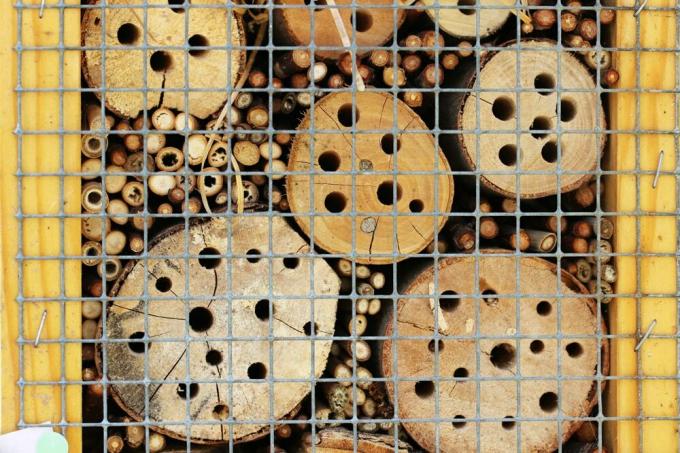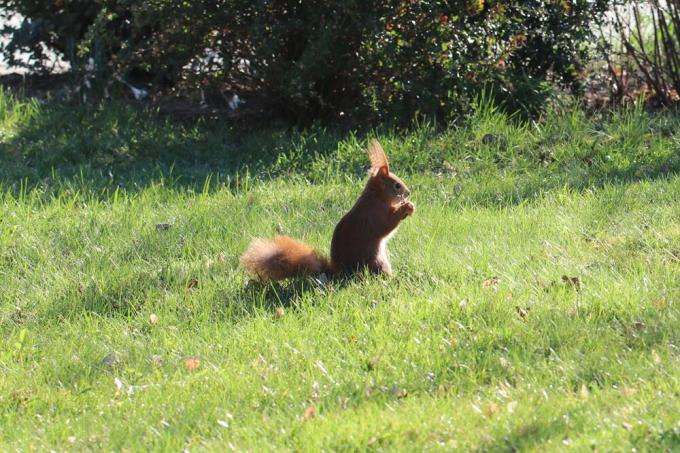

Table of contents
- Nest behavior of wild bees
- material selection
- seat selection
- hardwoods
- Tubes made of reeds and bamboo
- Stems, tendrils and pithy tubes
- interlocking tiles
In order to offer wild bees a welcome nesting place, you can easily build a wild bee house yourself. These nesting aids can be erected on your own with little expenditure of time and money. There are only a few limits to imagination and creativity, but there are a few important factors to consider when building. Above all, the right choice of material and sufficient protection against rain are crucial.
Nest behavior of wild bees
Wild bees are not limited to a specific solution when choosing their nesting site, but choose a suitable home in a very versatile way. Depending on the external circumstances and the size of the bee colony, the nest can vary greatly. Wild bees mostly nest in the ground, where the insects dig tunnels in the ground. Dry and sunny places are preferred as locations, these factors must also be considered when building a wild bee house. In addition, the insects also like to settle on vertical walls, which offer them good protection from predators. When the colony is smaller, wild bees often gnaw their nests into dead trees. Wild bee species that inhabit cavities are also very common; they prefer to settle in artificial wild bee houses.
- Build their brood cells mostly in underground tunnels
- Are also content with above-ground habitats
- Alternatively, wild bees look for passages in cliff edges and steep walls
- Others nest in the cavities of crevices in walls
- Above ground, hollow trees are often preferred
- Deadwood and the pith of woody stems also provide habitats
- Some species build free-standing nests out of resin
- Nest building from mineral mortar is also possible
material selection

Permeable materials are very important, otherwise fungi will form in the tubes of the wild bee brood if the water vapor cannot escape. Especially glass tubes are fatal, which are supposed to be used for observing the nesting activities inside. These unsuitable nesting aids often turn into a death trap for the offspring due to fungal infestation. If wood is to be used as a material, then it must not be too fresh. If, in addition, the holes are drilled too close together, unwanted cracks will appear, which the wild bees will avoid. In addition, drilling into the end-grain wood of tree sheaths promotes cracking. Softwoods are not suitable because they are not very durable and their wood fibers splinter quickly. Perforated and hollow bricks are also unsuitable as nesting aids, as their holes are either square or diamond-shaped.
- Nesting aids should be based on nature
- Choose breathable materials
- Only use well-seasoned wood
- Plan enough space for the drill holes
- Borings in the longitudinal wood are useful
- Only splinter-free nesting passages are populated
- Make sure the cut edges are clean and smooth
- Wild bees prefer the round holes in the interlocking tiles
- Freestanding and vertical structures are advantageous
- Disused bird nest boxes are also useful
seat selection
Ideally, the nesting aids should be provided with a stable hanger to protect them against wind and weather. As a result, they are also better protected against attacks by predators. A dry place is very important so that the front panels and inserts do not warp due to moisture penetrating from outside and thus become stuck. The spatial orientation of the location is also important, nesting aids facing north are not readily settled. Nests that are often shaded or dangling in the wind are just as unpopular. Most wild bee species overwinter in their nest and therefore need a place that is protected from extreme sub-zero temperatures.
- Either hang up or set up nesting aids in the selected place
- Permanently dry location, especially well protected from driving rain
- A free-standing wall, oriented from the south-east to the south-west, is ideal
- As sunny a place as possible, without disturbing draughts
- Depending on the construction, it can also be easily placed on a window sill
- In principle, nesting aids remain outside all year round
- Additionally protect against heavy forest during the winter months
- Curtain reed mat or plywood panel
- Keep a small distance to allow air circulation
- Protection helps against both extreme weather conditions and bird damage
hardwoods

Blocks made of well-seasoned hardwood are ideal for the wild bee house, as these are guaranteed to be populated by the insects. In addition, this wood does not tend to crack, even if the distance between the holes is too narrow. It is also important to ensure that the block of wood is not completely drilled through. In order to be able to offer as many wild bee colonies a home as possible, the diameter of the boreholes is crucial. Softwoods are completely unsuitable, as the escaping resin sticks together the filigree bee wings.
- The wood types beech, oak and ash are ideal
- Completely debark pieces of wood
- Drilled into the longitudinal wood where the bark used to be
- The diameter of the nest passages should be 2-10 mm
- The distance should be 2.5-3 times the diameter of the drill
- Pay attention to sharp and high-quality wood drill bits
- In this way, nest passages become smooth and splinter-free
- The deeper the boreholes, the better
- Drill holes should vary in diameter
Tubes made of reeds and bamboo
Nesting aids made of reed and bamboo tubes are very easy to make. In this way, a lot of living space can be accommodated in a small space and offered to the wild bees. The materials for this can be obtained from a conventional hardware store. If this nesting aid is hung on the wall with a little distance, the house wall behind does not get dirty so quickly. In addition, the insects can then enter and exit via the back door and thus receive additional protection against predators.
- Cut strips of reed or bamboo rolls about 20 cm wide
- Work with a fine saw to ensure splinter-free tubes
- Roll up the tubes tightly
- Then tie tightly together
- Use weatherproof materials for lacing
- Worn-out belts and robust fabrics are ideal
- Scrape the entrances of the individual tubes well
- Drill out the pith of the bamboo tubes
- Pin a small wooden slat to the back
- This creates sufficient distance to the wall
- Attach firmly to avoid rocking motion
Stems, tendrils and pithy tubes

Some wild bee species prefer to live in hollow stalks, which is why the tendrils, tubes and stalks of various plants are well suited as starting material for nesting aids. The nesting tunnels are dug into the soft marrow by the wild bees at will. These are set up standing and can be installed in many areas in the garden, on the house and on the terrace. If the stems are attached horizontally, they are usually not colonized at all.
- Stalks of blackberries, raspberries, reeds and summer lilac are ideal
- Alternatively, tendrils of elderberry, mullein, motherwort and evening primrose are also possible
- Just snap off the ends to give the insects an entry point
- Tie them in bundles to wooden sticks, drainpipes or the garden fence
- Place in a sunny position in spring
interlocking tiles
The interlocking tile is proven to be the oldest roofing material made from fired clay. These bricks are interlocked on the sides and have round hollow chambers in the longitudinal direction on the visible side. The punched edge is either scalloped, straight or round. The bricks offer good protection against rain, as only the top one gets completely wet. - In this way, the entire roof can be made bee-friendly and a useful habitat can be created for the insects.
- Stack interlocking tiles to form a small tower
- Set up in a protected place
- Ideal is under the canopy or in the open shed
- Makes a useful nesting aid with lots of holes
- Mason bees in particular settle here
 garden editorial
garden editorial I write about everything that interests me in my garden.
Learn more about beneficial insects

What does hedgehog droppings look like? | Recognize hedgehog droppings
Hedgehogs are not only very cute, but also useful animals. a. devour the unpopular slugs in the garden. They feel particularly comfortable in natural gardens. Their legacies, which can even be hazardous to health, are less pleasant.

What does raccoon droppings look like? How to recognize him
Raccoons are purely outwardly, quite cute contemporaries. However, this does not hide the fact that these are wild animals that can cause great damage in the garden and on the house. This masked intruder can pose a danger to residents and pets.

Recognizing squirrel droppings: typical appearance with picture
Gardens provide an oasis for many wild animals to forage there. The animal visitors leave clearly visible traces in the form of droppings. If you take a closer look at the pieces of excrement, you can see which animal was the cause based on certain clues.

Recognizing fox droppings: 5 characteristics with a picture of the fox droppings
If animal droppings are found in the garden, it is annoying in any case. However, there can also be a danger with fox droppings in particular. But how can fox droppings be recognized and what should be considered when removing it?

drive away wild bees | What to do against wild bees in the garden?
If you want to drive away and get rid of wild bees, you should use natural and gentle means. Because the insects are useful in the garden and generally important for the environment. In addition, they are rarely threatening. We reveal how the fight works.

List: these ant species exist in Germany - ants
Ants can be found everywhere, whether in the forest, on a roadside, in the garden or even on the terrace and in the house if there is something interesting for the animals. But not all ants are the same, there are over 13,000 species of ants worldwide, 200 of them in Europe alone.

